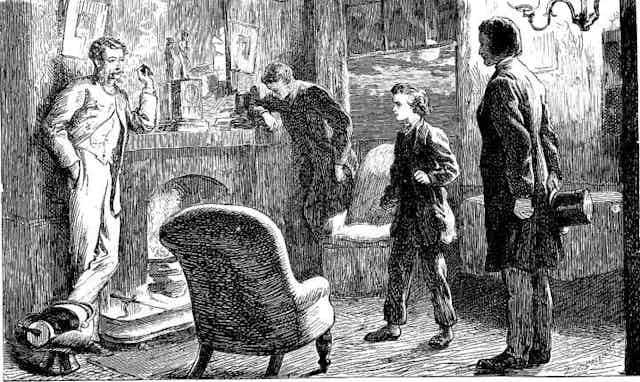Dickens created some of the best-known characters in fiction. The likes of Ebenezer Scrooge, Oliver Twist and David Copperfield are still well-remembered, 150 years after his death – and are regularly updated through new stage and screen adaptions. One of the reasons why his characters have become part of popular culture is Dickens’s ability to exaggerate and caricature but at the same time also deeply understand human character.
Behaviours that he describes in his novels still resonate today, as in a recent comment by a political editor who describes a lack of decisive action on coronavirus as a “Micawberish conviction in government that something would turn up”, in reference to Dickens’s memorable comic hero and unshakeable optimist in David Copperfield.
Read more: David Copperfield on screen: Charles Dickens' masterpiece is a celebration of everyday heroes
The striking and individualising features of his characters have received much critical and popular attention. Yet, crucial to Dickens’s authorial techniques – and hence the public’s love of his characters – is also the description of conventional ways of behaving. Common features make fictional people more like normal people. As with anything in life, we don’t quite notice what’s “normal” until it isn’t any more.
This is where digital methods come in. Treating Dickens’s novels as a dataset makes it possible to identify patterns based on formal repetitions and frequencies – the type of information we are not consciously aware of when we a read a novel.
A common stance
Analysing Dickens’s novels as one single dataset (or “corpus”) shows us that, as in normal life, a type of common behaviour is that people often have or put their hands in their pockets, as Fledgeby in Our Mutual Friend.
‘But why’, said Fledgeby, putting his hands in his pockets and counterfeiting deep meditation, ‘why Riah should have started up, when I told him that the Lammles entreated him to hold over a Bill of Sale has has on all their effects.’
When we read a novel, such a description can easily go unnoticed. Why would we pay particular attention to what people do with their hands – unless it is clearly meaningful.
It’s the same in real life – we would not normally pick up on body language, unless it strikes us as unusual and unfamiliar. But looking at several novels at the same time makes patterns of repeated and commonly occurring behaviours more clearly visible.
This can be achieved with the help of a “concordance” tool that displays all occurrences of a word or phrase with a specified amount of context to the left and right. Below is a sample from a concordance for the phrase “his hands in his pockets” in Dickens’s novels, retrieved with the free web application CLiC.

Importantly, it is not only Dickens who depicts such everyday behaviour. We find examples in other 19th-century fiction, too:
Mr. Earnshaw vouchsafed no answer. He walked up and down, with his hands in his pockets, apparently quite forgetting my presence; and his abstraction was evidently so deep, and his whole aspect so misanthropical. Emily Brontë, Wuthering Heights
He sauntered on, with his hands in his pockets, humming the chorus of a comic song.
Wilkie Collins, Armadale
While such phrases often appear circumstantial rather than central to plot or character, they fulfil important functions in drawing the reader into the text. The description of conventional behaviour makes fictional people more like real people, subtly creating a link between what the reader knows about how people “normally” behave or how fictional people are generally depicted across novels.
What, however, is the norm that we measure fictional characters against? Behaviours and body language change over time. So it is little surprise that in the 19th century it was mainly men who were described with their hands in their pockets.
Depicting power
Exploiting conventions and subtleties also enabled Dickens to draw attention to exceptional behaviours. Another common pattern of body language that occurs across 19th-century fiction is men standing with their back to the fire, a pose connected to power and confidence of the man of the house.
In Dickens, we also find a woman, Mrs Pipchin (in Dombey and Son), who is depicted in a situation where she stands with her back to the fire. This is no coincidence. As a widow, Mrs Pipchin looks after herself, and the way in which she runs her boarding house for children does not show her to be a character who displays stereotypical, female qualities.
… and Mrs Pipchin, with her back to the fire, stood, reviewing the new-comers, like an old soldier.
Dombey and Son
The interplay of norms and deviations from norms also becomes apparent in the wide range of body language references that Dickens uses. References to eyes are generally common in fiction, as can be shown with frequency data retrieved by tools like CLiC. Typical patterns we find in Dickens (and elsewhere) concern the direction and duration of gaze.
‘And what’, said Mr Pecksniff, turning his eyes on Tom Pinch, even more placidly and gently than before, ‘what have YOU been doing, Thomas, humph?’
Martin Chuzzlewit
Body parts that are less frequent are teeth. So using teeth in a similar way to eyes makes these body parts a more strikingly characterising feature.
‘May I be allowed, Madam,’ said Carker, turning his white teeth on Mrs Skewton like a light – ‘a lady of your excellent sense and quick feeling will give me credit.’
Dombey and Son
With Dickens’s ability to both create individualised, memorable characters as well as subtly connect to our experience of encountering people more generally, his novels still speak to readers today.
The contexts in which modern readers interact with the texts have changed, and in today’s digital world we can draw on new tools to view and understand the people Dickens has given us. After 150 years, we not only remember Dickens’s fictional characters, but we can still find out more about them.

